The 12th Planet (26 page)
Authors: Zecharia Sitchin
Tags: #Non-Fiction, #Gnostic Dementia, #Fringe Science, #Retail, #Archaeology, #Ancient Aliens, #History

"My friend,
Cast a glance at how the land appears!
The land has turned into a furrow....
The wide sea is just like a bread-basket."...
When he had borne him aloft a third
beru,
The Eagle says to him, to Etana:
"See, my friend, how the land appears!
The land has turned into a gardener's ditch!"
And then, as they continued to ascend, Earth was suddenly out of sight.
As I glanced around, the land had disappeared,
and upon the wide sea mine eyes could not feast.
According to one version of this tale, the Eagle and Etana did reach the Heaven of Anu. But another version states that Etana got cold feet when he could no longer see Earth, and ordered the Eagle to reverse course and "plunge down" to Earth.
Once again, we find a biblical parallel to such an unusual report of seeing Earth from a great distance above it. Exalting the Lord Yahweh, the prophet Isaiah said of him: "It is he who sitteth upon the circle of the Earth, and the inhabitants thereof are as insects."
The tale of Etana informs us that, seeking a
shem,
Etana had to communicate with an Eagle inside a pit. A seal depiction shows a winged, tall structure (a launch tower?) above which an eagle flies off. (Fig. 78)
What or who was the Eagle who took Etana to the distant heavens?
We cannot help associating the ancient text with the message beamed to Earth in July 1969 by Neil Armstrong, commander of the Apollo 11 spacecraft: "Houston! Tranquility Base here. The
Eagle
has landed!"
He was reporting the first landing by Man on the Moon. "Tranquility Base" was the site of the landing;
Eagle
was the name of the lunar module that separated from the spacecraft and took the two astronauts inside it to the Moon (and then back to their mother craft). When the lunar module first separated to start its own flight in Moon orbit, the astronauts told Mission Control in Houston: "The
Eagle
has wings."
But "Eagle" could also denote the astronauts who manned the spacecraft. On the Apollo 11 mission, "Eagle" was also the symbol of the astronauts themselves, worn as an emblem on their suits. Just as in the Etana tale, they, too, were "Eagles" who could fly, speak, and communicate. (Fig. 79)
How would an ancient artist have depicted the pilots of the skyships of the gods? Would he have depicted them, by some chance, as eagles?
That is exactly what we have found. An Assyrian seal engraving from circa 1500
B.C.
shows two "eagle-men" saluting a
shem!
(Fig. 80)
Numerous depictions of such "Eagles"—the scholars call them "bird-men"—have been found. Most depictions show them flanking the Tree of Life, as if to stress that they, in their
shem's,
provided the link with the Heavenly Abode where the Bread of Life and Water of Life were to be found. Indeed, the usual depiction of the Eagles showed them holding in one hand the Fruit of Life and in the other the Water of Life, in full conformity with the tales of Adapa, Etana, and Gilgamesh. (Fig. 81)
The many depictions of the Eagles clearly show that they were not monstrous "bird-men," but anthropomorphic beings wearing costumes or uniforms that gave them the appearance of eagles.
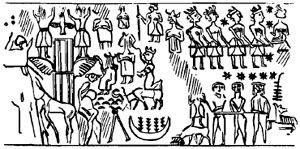
Fig. 78
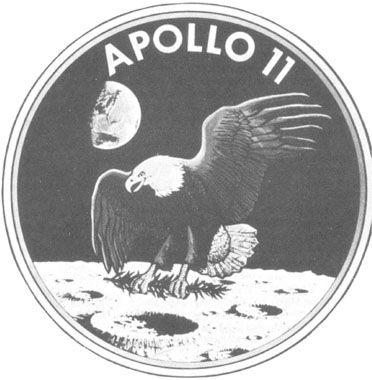
Fig. 79
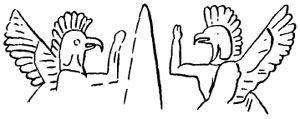
Fig. 80
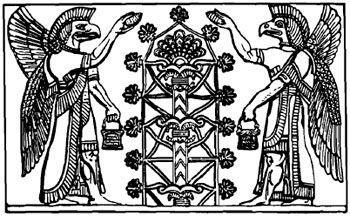
Fig. 81
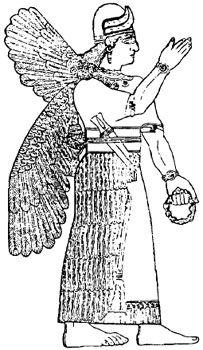
Fig. 82
The Hittite tale concerning the god Telepinu, who had vanished, reported that "the great gods and the lesser gods began to search for Telepinu" and "Shamash sent out a swift Eagle" to find him.
In the Book of Exodus, God is reported to have reminded the Children of Israel, "I have carried you upon the wings of Eagles, and have brought you unto me," confirming, it seems, that the way to reach the Divine Abode was upon the wings of Eagles—just as the tale of Etana relates. Numerous biblical verses, as a matter of fact, describe the Deity as a winged being. Boaz welcomed Ruth into the Judaean community as "coming under the wings" of the God Yahweh. The Psalmist sought security "under the shadow of thy wings" and described the descent of the Lord from the heavens. "He mounted a Cberub and went flying; He soared upon windy wings." Analyzing the similarities between the biblical El (employed as a title or generic term for the Deity) and the Canaanite El, S. Langdon
(Semitic Mythology)
showed that both were depicted, in text and on coins, as winged gods.
The Mesopotamian texts invariably present Utu/Shamash as the god in charge of the landing place of the
shem's
and of the Eagles. And like his subordinates he was sometimes shown wearing the full regalia of an Eagle's costume. (Fig. 82)
In such a capacity, he could grant to kings the privilege of "flying on the wings of birds" and of "rising from the lower heavens to the lofty ones." And when he was launched aloft in a fiery rocket, it was he "who stretched over unknown distances, for countless hours." Appropriately, "his net was the Earth, his trap the distant skies."
The Sumerian terminology for objects connected with celestial travel was not limited to the
me's
that the gods put on or the
mu's
that were their cone-shaped "chariots."
Sumerian texts describing Sippar relate that it had a central part, hidden and protected by mighty walls. Within those walls stood the Temple of Utu, "a house which is like a house of the Heavens." In an inner courtyard of the temple, also protected by high walls, stood "erected upwards, the mighty APIN" ("an object that plows through," according to the translators).
A drawing found at the temple mound of Anu at Uruk depicts such an object. We would have been hard put a few decades ago to guess what this object was; but now we readily recognize it as a multistage space rocket at the top of which rests the conical
mu,
or command cabin. (Fig. 83)
The evidence that the gods of Sumer possessed not just "flying chambers" for roaming Earth's skies but space-going multistage rocket ships also emerges from the examination of texts describing the sacred objects at Utu's temple at Sippar. We are told that witnesses at Sumer's supreme court were required to take the oath in an inner courtyard, standing by a gateway through which they could see and face three "divine objects." These were named "the golden sphere" (the crew's cabin?), the GIR, and the
alikmahrati
—
a
term that literally meant "advancer that makes vessel go," or what we would call a motor, an engine.

Fig. 83
What emerges here is a reference to a three-part rocket ship, with the cabin or command module at the top end, the engines at the bottom end, and the
gir
in the center. The latter is a term that has been used extensively in connection with space flight. The guards Gilgamesh encountered at the entrance to the landing place of Shamash were called gir-men. In the temple of Ninurta, the sacred or most guarded inner area was called the GIRSU ("where the
gir
is sprung up").
